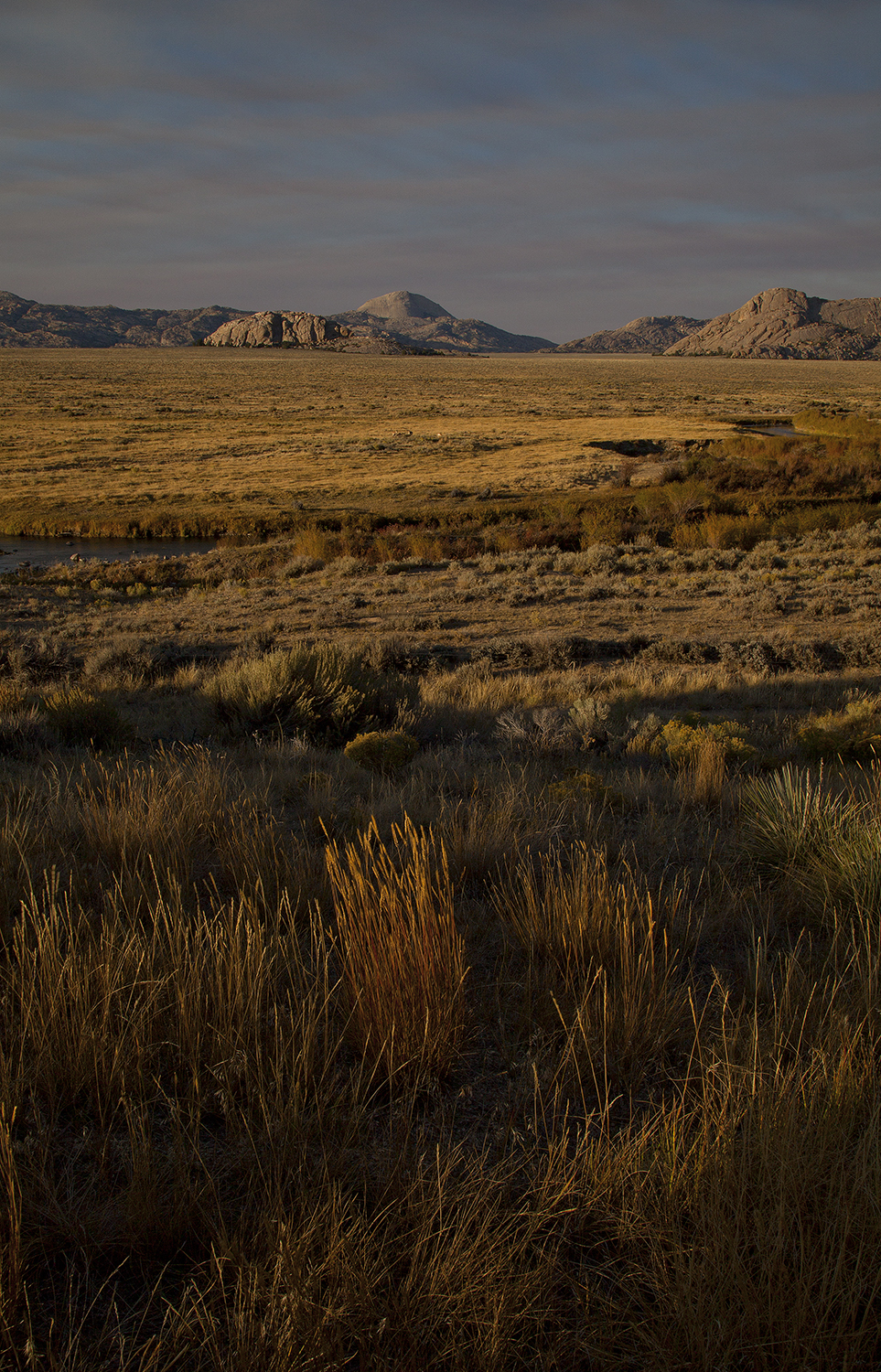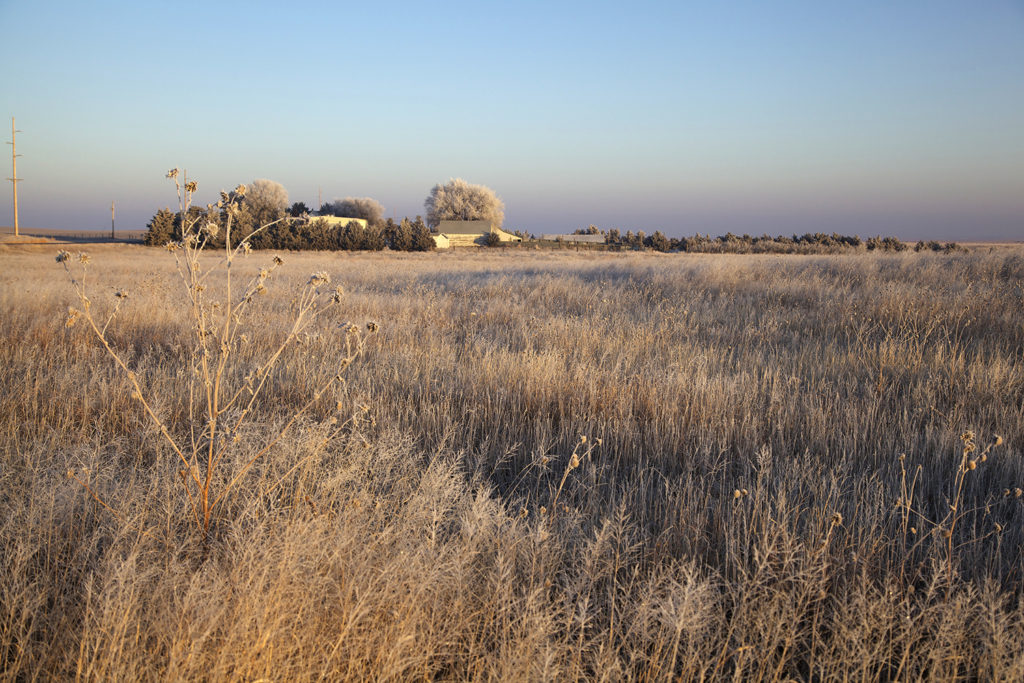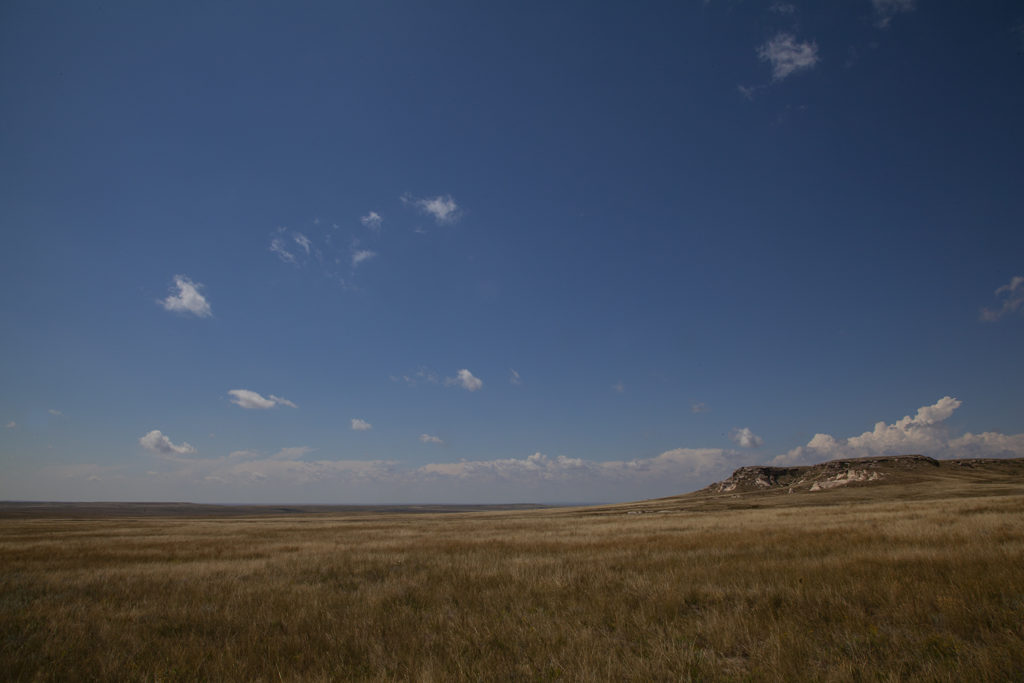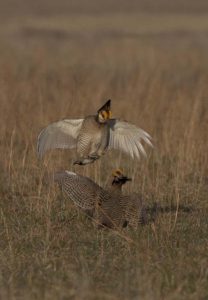
The treeless sagebrush grasslands of the intermountain West trap huge amounts of carbon and provide critical habitat for a host of wildlife species, many of which cannot survive on any other landscape. Photo copyright 2015, Chris Madson, all rights reserved.
I CAN’T REMEMBER EXACTLY WHEN I MADE MY FIRST ACQUAINTANCE WITH A GARDEN HOE— IT’S TOO LONG AGO— BUT I think it was about the time I learned to read. My mother introduced us. I clearly remember the tongue-lashing she gave me when, accidentally on purpose, I chopped down a row of okra in her vegetable garden in my day-to-day combat with the weeds. When she discovered the atrocity and called me to account, I used the classic kid defense: blank-faced ignorance. I didn’t know what it was, I protested. But I really did. I never was a big fan of okra. . . .
We lived on the bluffs overlooking the Mississippi River just downstream from the mouth of the Illinois, and I got to know the dirt in mom’s garden in the intimate way one learns about soil at the end of a hoe. It was heavy, yellow clay left over from the days, not all that far distant, when the ridge top had been covered in red and white oak, shagbark hickory, and black cherry.
The man who cleared that ground had been none too careful with it, so the layer of thin brown topsoil that had once lain under the trees had washed down the hill, down the creek, and, by the time I started hoeing, had probably made it all the way to the Louisiana delta. What was left was sticky when wet and concrete-hard when dry, even after mom had convinced dad to mix in some old cow manure from the abandoned dairy barn down the road.
It was the contrast that made such a powerful impression on me.
We were visiting my grandmother in Story County, Iowa. She lived in a small frame bungalow with a sagging back porch and a cellar that smelled of potatoes. I was in the front yard, killing time until the adults loaded us into the station wagon for the drive out to Uncle Cliff’s for the annual Fourth of July gathering, hands in my pockets, no time to find any mischief, just standing on the bluegrass lawn, scuffing the ground with the toe of my Chuck Taylor All-Stars.
The dirt made dark gray puffs of dust as I stirred it, which was something unusual in my experience. I knelt down and took a pinch of the soil. It came away in fine crumbles, as black and feathery as the ash of burned paper in the palm of my hand. Although I didn’t realize it at the time, I suspect it was the exactly the same moment of discovery that convinced my Norwegian ancestors to end their long trek from the home country only a few miles from where I knelt, hitching up the breaking plow to three yoke of oxen and turning the tallgrass upside down in pursuit of that rich, black earth— the truest, most abiding wealth of the New World.
It’s no accident that central Iowa’s topsoils look like ash. They contain a remarkable amount of carbon. Their appearance and their immense productivity are both due to the accumulation of organic matter over the 12,000 years since the last glacier began its retreat[i] and, especially, over the last 8,000 years,[ii] as the plants of the tallgrass prairie sent their roots and rhizomes as far as sixteen feet below the surface in search of water and nutrients.[iii]

The permanent cover established on land retired under provisions of the Conservation Reserve Program begin the long process of replenishing carbon in the soil that was lost when the land was tilled. Photo copyright 2015, Chris Madson, all rights reserved.
As much as two-thirds of the plant mass in a tallgrass prairie is underground,[iv] largely out of reach of drought, frost, hail, fire, or any of the other stresses the flatlands can inflict on growing things. Much of the organic matter in these roots stays in the ground after the plant dies. It’s carbon, the same black carbon found in ash. It gives the soil its color and, up near the surface, its immense fertility. Farther down, out of reach of the oxygen-rich atmosphere, shallow roots, bacteria, and other decomposers, this carbon is more or less permanently trapped. Which could be a powerful tool in our effort to trap greenhouse gases.
We’ve finally recognized that pumping carbon into the atmosphere, mainly in the form of carbon dioxide, is warming the entire planet and threatens our future. In response to that problem, environmentalists and politicians have been looking for ways to reduce our carbon dioxide emissions, while engineers have been working on technological methods for removing carbon from the atmosphere.
Ecologists have pointed out that there is a less mechanical way of doing that. It’s called photosynthesis. It’s part of the process that trapped all that energy in fossil fuels like oil and coal several hundred million years ago. This basic biochemical fact has led some scientists to recommend a straightforward approach to removing carbon from the atmosphere: plant trees. A lot of trees.
Last year, a group of researchers estimated that the earth has 3.5 million square miles that could support forest but currently have none. They figure that planting trees on that area could eventually trap 226 billion tons of carbon.[v] This led to public campaigns to plant a billion trees, 8 billion trees, even a trillion trees to help fight climate change.
Some of the assumptions of the study itself have been called into question, and there are experts who argue that helping indigenous peoples protect the tropical forests that exist is a better idea than planting a bunch of seedlings. No one’s against the idea of using forests to help trap carbon, but there’s an awkward fact the tree-planting campaigns generally ignore: Trees won’t grow everywhere. And, since large parts of the world’s land mass continue to dry out with the warming climate, the area that won’t grow trees is likely to expand, not shrink.

Shortgrass prairie on the high plains of western Nebraska. While this native vegetation traps less carbon than the lush tallgrass prairies to the east, it still locks huge amounts of carbon underground where it cannot be released by fire. Carbon sequestration with trees won’t work on this arid landscape. Photo copyright 2017, Chris Madson, all rights reserved.
After considering this snag in an otherwise laudable strategy, a different group of scientists, this bunch at U.C. Davis, took a look at the predicted shifts in climate across the state of California and estimated the probable loss in forest acreage that would result. They expected that frequent wildfires and persistent drought would reduce the amount of carbon trapped by the vegetation, but grasslands, whose carbon is stored mainly underground and whose plants are better at handling drought, managed to store much more carbon than forests. In the most extreme climate change scenarios they examined, the difference amounted to more than 400 million tons of carbon. They concluded that “the inherent resilience of grassland vegetation to drought and wildfire translates to a more reliable C sink than forest ecosystems in response to 21st century climate changes.”[vi] At least, in California.
This research has generated plenty of debate, based, as it is, on modeling and several assumptions that are open to question. What isn’t open to question is the fact that some landscapes grow grass better than they grow trees. And there is no doubt that grasslands remove substantial amounts of carbon from the atmosphere.
How much? Researchers measured the carbon in the soil under a scrap of original tallgrass prairie in southern Wisconsin and found almost 160 tons of carbon to the acre. The soil under a nearby piece of ground that had been planted to tallgrass species sixty-five years before the study held about half as much, but still an impressive amount, all of it out of reach of fire or drought.[vii]
Forests in the same region store about eight-five tons of carbon, and three-fourths of that is locked up in wood and other vegetation above ground, where it can be quickly moved back into the atmosphere by fire, harvest for lumber, and, in the understory, by grazing or browsing.[viii]

The lesser prairie chicken is one of several grassland specialists that have declined as America’s native grasslands have been destroyed. Photo copyright 2014, Chris Madson, all rights reserved.
Not all grasslands store carbon as efficiently as the Midwest’s tallgrass prairie. As precipitation wanes out on the high plains, productivity in native grasslands drops, along with the amount of carbon trapped in the soil. But it’s clear that, whatever the grasses and broad-leafed plants that make up native prairie, they store massive amounts of carbon in growing conditions no tree could survive.
Plow that prairie, and it loses at least half of the carbon locked in the soil. Restore that prairie on ground that has been converted to cropland, and the amount of carbon in the soil increases steadily but slowly. It may take a century to get back to the amount of carbon that was originally trapped by the native plants, but get there we can.
Any savvy bird hunter will recognize the practical implications in all this soil science. If we care about prairie grouse and the declining hosts of nongame prairie birds, we’re wise to avoid plowing the native grasslands we have left. That doesn’t mean they’re lost to agriculture— they can produce a lot of animal protein when judiciously grazed and still keep the carbon in the ground instead of in the air.
And returning cropland to permanent prairie cover through programs like the Conservation Reserve and CREP is a good idea. These restorations have all the short-term benefits we’ve come to appreciate— better air and water quality, reduced soil erosion, dramatically improved wildlife habitat for a host of birds and mammals, and a guaranteed revenue stream for farmers who face ever-growing uncertainty in weather and international markets.
They also help moderate climate change.
In the modern era of conservation, it’s not often that a “win-win-win” approach to a set of problems turns up. I think this is one.
———–
[i] Prior, Jean C., 2017. Des Moines Lobe. Iowa Geological Survey. https://www.iihr.uiowa.edu/igs/des-moines-lobe/. Accessed August 10, 2020.
[ii] Walker, P.H. and Grace S. Bush, 1963. Observations on bog and pollen stratigraphy of the Des Moines Glacial Lobe, Iowa. Proceedings of the Iowa Academy of Science, 70 (1): 253-260. https://scholarworks.uni.edu/cgi/viewcontent.cgi?article=2299&context=pias. Accessed August 10, 2020.
[iii] Weaver, J.E., 1954. North American Prairie. Johnsen Publishing Company, Lincoln, NE. p.246.
[iv] Kucharik, C.J., Nathan J. Fayram, and Kimberly Nicholas, 2006. A paired study of prairie carbon stocks, fluxes, and phenology: comparing the world’s oldest prairie restoration with an adjacent remnant. Global Change Biology 12: 122-139. https://onlinelibrary.wiley.com/doi/abs/10.1111/j.1365-2486.2005.01053.x.
[v] Basin, Jean-Francois, et al., 2019. The global tree restoration potential. Science 365, Issue 365: 76-79. https://science.sciencemag.org/content/365/6448/76/tab-pdf. Accessed August 10, 2020.
[vi] Dass, Pawolok, Benjamin Z. Houlton, Yingping Wang, and David Warlind, 2018. Environmental Research Latters 13 (2018): 074027.
[vii] Kucharik, C.J., Nathan J. Fayram, and Kimberly Nicholas, 2006. A paired study of prairie carbon stocks, fluxes, and phenology: comparing the world’s oldest prairie restoration with an adjacent remnant. Global Change Biology 12: 122-139. https://onlinelibrary.wiley.com/doi/abs/10.1111/j.1365-2486.2005.01053.x.
[viii] Birdsey, Richard A., 1992. Carbon storage and accumulation in United States forest ecosystems. United States Department of Agriculture, Forest Service General Technical Report WO-59. P.4. https://www.nrs.fs.fed.us/pubs/gtr/gtr_wo059.pdf. Accessed August 13, 2020.
Leave a Reply
You must be logged in to post a comment.